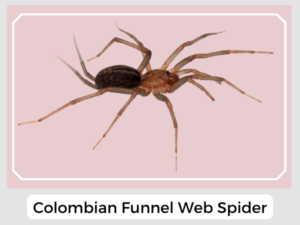Step into the world of the Colombian funnel web spider! Part of the curtain web spider family, this critter loves to call Colombia its home. We’ve gathered some fun and interesting facts about this spider for you to explore.
The eggs are kept in a protective cocoon spun by their mother.
Spiderlings are yellow when they emerge from their eggs.
They build silk-lined burrows near crevices.
Yes, Colombian Funnel Web spiders have venom. Their venom can be pretty lethal, though only 10-15% of bites are life-threatening.
They can! But these spiders are usually quite shy. While not aggressive by nature, these spiders will attack if they feel threatened.
The Colombian funnel web spider plays a vital role in controlling the population of insects, acting as a natural pest manager. Their nocturnal hunting habits and stealthy behavior make them formidable predators in their ecosystems.
Natural Predator: Birds, small mammals, and other larger spiders can pose a threat to the Colombian funnel web spider, serving as natural population controls within their environment.
Prey-Predator Dynamics: Within their ecological niche, Colombian funnel web spiders are apex invertebrate predators, managing insect populations, and thus influencing the health of their habitat.
Relationship with Humans: Human encounters with these spiders are infrequent due to their secluded nature. However, they hold ecological value by reducing pest insects. Awareness and caution are advised due to their venomous nature, but these spiders generally avoid human interaction.
| Lifespan | 20 years |
| Distribution | South America, primarily Colombia |
| Habitat | Crevices and holes in rocks, logs, and rotten trees |
| Diet | Insects such as cockroaches and crickets |

In summary, the Colombian funnel web spider is an impressive species, with a long lifespan and a significant ecological role.
Step into the world of the Colombian funnel web spider! Part of the curtain web spider family, this critter loves to call Colombia its home. We’ve gathered some fun and interesting facts about this spider for you to explore.
The eggs are kept in a protective cocoon spun by their mother.
Spiderlings are yellow when they emerge from their eggs.
They build silk-lined burrows near crevices.
Yes, Colombian Funnel Web spiders have venom. Their venom can be pretty lethal, though only 10-15% of bites are life-threatening.
They can! But these spiders are usually quite shy. While not aggressive by nature, these spiders will attack if they feel threatened.
The Colombian funnel web spider plays a vital role in controlling the population of insects, acting as a natural pest manager. Their nocturnal hunting habits and stealthy behavior make them formidable predators in their ecosystems.
Natural Predator: Birds, small mammals, and other larger spiders can pose a threat to the Colombian funnel web spider, serving as natural population controls within their environment.
Prey-Predator Dynamics: Within their ecological niche, Colombian funnel web spiders are apex invertebrate predators, managing insect populations, and thus influencing the health of their habitat.
Relationship with Humans: Human encounters with these spiders are infrequent due to their secluded nature. However, they hold ecological value by reducing pest insects. Awareness and caution are advised due to their venomous nature, but these spiders generally avoid human interaction.
| Lifespan | 20 years |
| Distribution | South America, primarily Colombia |
| Habitat | Crevices and holes in rocks, logs, and rotten trees |
| Diet | Insects such as cockroaches and crickets |

In summary, the Colombian funnel web spider is an impressive species, with a long lifespan and a significant ecological role.